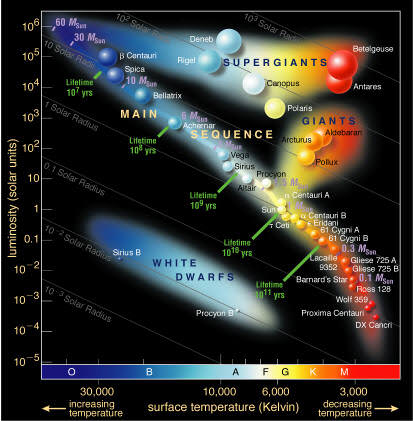[/caption]
Stars can be big or small, hot or cool, young or old. In order to properly organize all of the stars out there, astronomers have developed an organizational system called the Hertzsprung-Russell Diagram. This diagram is a scatter chart of stars that shows their absolute magnitude (or luminosity) versus their various spectral types and temperatures. The Hertzsprung-Russell diagram was developed by astronomers Ejnar Hertzsprung and Henry Norris Russell back in 1910.
The first Hertzsprung-Russell diagram showed the spectral type of stars on the horizontal axis and then the absolute magnitude on the vertical axis. Another version of the diagram plots the effective surface temperature of the star on one axis and the luminosity of the star on the other.
By using this diagram, astronomers are able to trace out the life cycle of stars, from young hot protostars, through the main sequence phase and into the dying red giant phases. It also shows how temperature and color relate to the stars at various stages in their lives.
If you look at an image of a Hertzsprung-Russell diagram, you can see there’s a diagonal line from the upper left to the lower right. Almost all stars fall along this line, and it’s known as the main sequence. In general, as luminosity goes down, temperature goes down as well. But there’s a branch that goes off horizontally at the 100 solar luminosity mark. These are the red giant stars nearing the end of their lives. They can be bright and cool, because they’re so large. But this stage usually only lasts a few million years.
Astronomers can also use the Hertzsprung-Russell diagram to estimate how far away stellar clusters are from Earth. By mapping out all the stars in the cluster and grouping them together and comparing them to groups of stars with known distances.
We have written many articles for Universe Today about the star life cycle. Here’s an article about the cluster M13, and how astronomers use the Hertzsprung-Russell diagram to study it.
Here are some good resources on the Internet for Hertzsprung-Russell diagram. Here’s a very simple version of the diagram from the University of Oregon, and here’s more information.
We have recorded an episode of Astronomy Cast about kinds of stars. Listen to it here, Episode 75 – Stellar Populations.
References:
http://cse.ssl.berkeley.edu/segwayed/lessons/startemp/l6.htm
http://cas.sdss.org/dr6/en/proj/advanced/hr/

